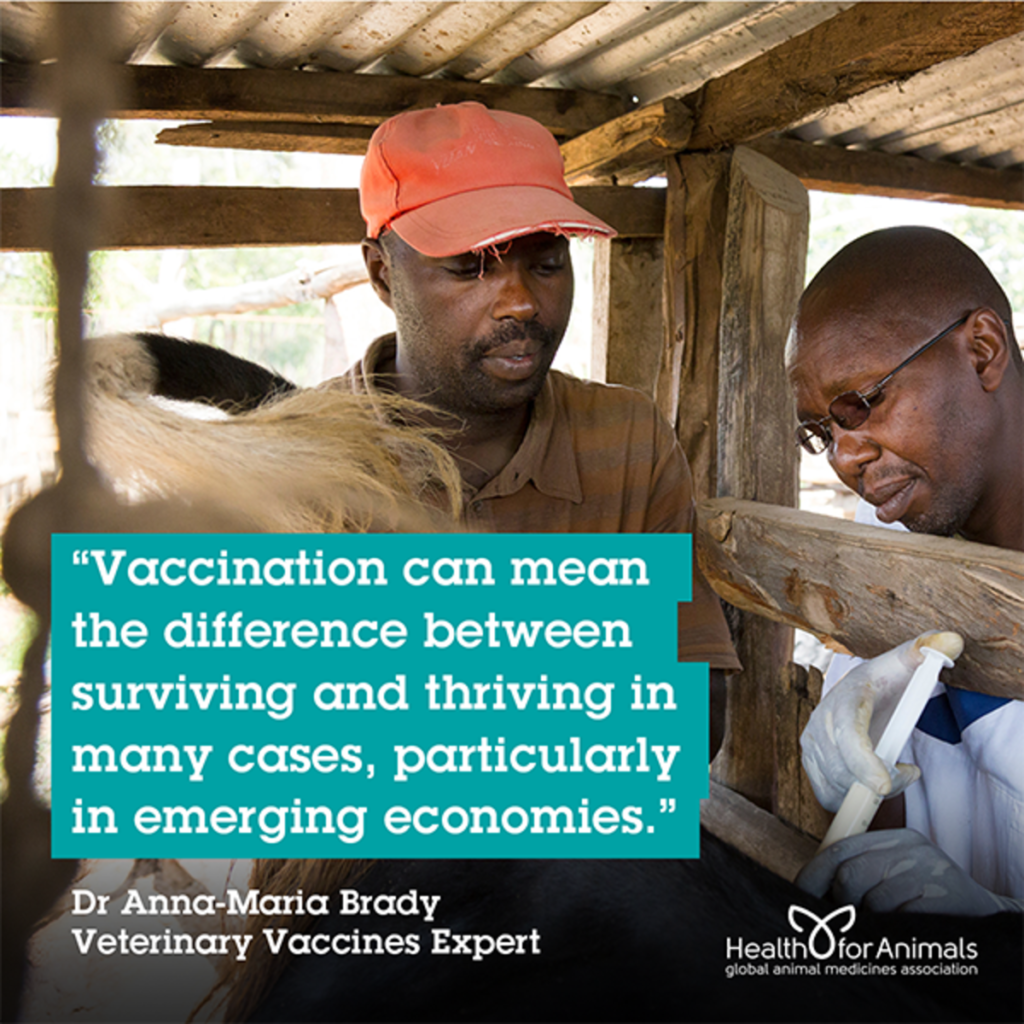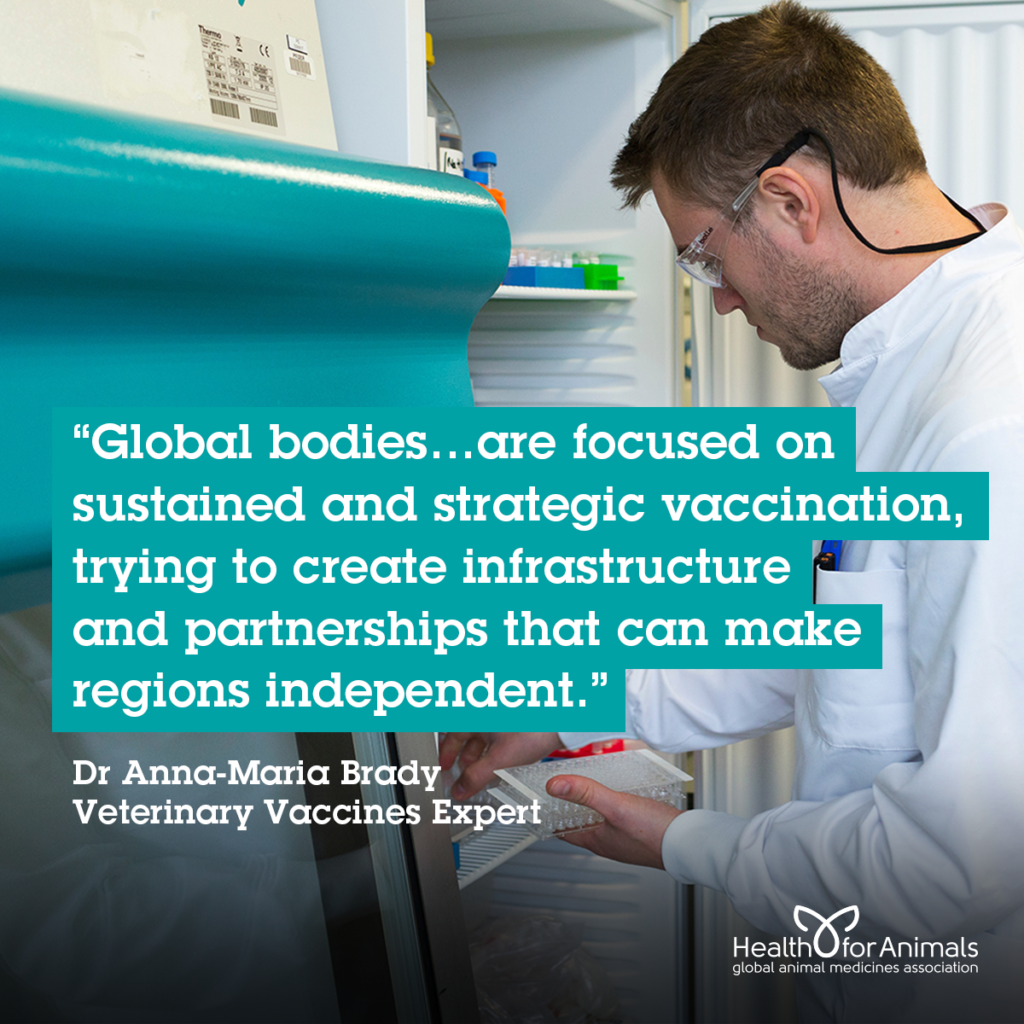Resources: Articles
Interview: Hurdles to Vaccination
Across the world, scientists and veterinarians agree that vaccines are of the upmost importance to animal health, as well as human health. However, after 200 years of use, including successfully eradiating devastating animal diseases such as rinderpest, we still aren’t using them to their full potential.
Veterinary Vaccines Expert Anna-Maria Brady is currently investigating the major hurdles to vaccination in a new report commissioned by HealthforAnimals. Here she reveals some of her major findings and discusses potential solutions.

Why do you think a report like this is needed at this time?
Vaccines are powerful tools that can be used proactively to protect against disease, but we aren’t using them to their full potential. They increase the efficiency and safety of our food production, decrease the need for antibiotics and most importantly, prevent our animals from getting sick so they can have a better quality of life. They improve our health too, as we know that 75% of emerging diseases in humans have an animal origin.
Vaccination can mean the difference between surviving and thriving in many cases, particularly in emerging economies. For example, in Kenya, vaccination against the East Coast Fever helped increase farmers’ annual income, allowing many to educate girls in the family for the first time
By understanding the major barriers to animal vaccination across different markets and stakeholder groups, we hope to be able to foster more collaboration and help support better vaccination rates; we can also help identify the short-term wins maybe and where more permanent infrastructure changes are required.

So why, despite the obvious huge advantages, aren’t we using vaccines to their maximum?
After speaking with a number of experts in the field across industry, academia, large agencies and NGOs, six major hurdles were clear:
- Economic and financial
- Political and trade
- Availability and lack of practicality for use in the field
- Social / perception issues
- Technical / scientific hurdles
- Regulatory
Out of these, finance is the dominant theme, but once affordability is overcome and a positive cost benefit becomes evident, the second major hurdle is political. It dictates whether you have the infrastructure in your country to be able to easily vaccinate. For example, if you don’t have an animal health department in your government, then there’s not the resources or people to put a vaccination strategy in place. If you don’t have sufficient government veterinarians on the ground, you can’t properly monitor whether you have a disease under control, which means, you can’t report findings to vets and professionals in the field. Evidence shows this makes a huge difference to uptake of vaccines.
Could you give an example of how these hurdles appear in practice?
Sure. So, let’s consider a country where a global company is trying to enter an emerging market. The multinational needs to get their products authorised so they must talk to the regulatory authority. They might say, we have this vaccine authorised for use in North America and we think it’s relevant to you, but then the region may say, that’s for a North American strain so it’s not relevant to us. The company is then forced to do scientific studies within the country to show that region has the same strains as in North America. It’s high risk and can take five years or more of research and bureaucracy.
Practically administering vaccines in the field can be another major challenge in some counties. For example, if you’re going to vaccinate against rabies in Africa, transport is an issue. Many medicines needs to be stored at 4 – 8°C and refrigeration is expensive. Many farmers and communities in the middle of rural Africa simply aren’t able to store medicines properly.
How can we better support vaccination in certain countries or regions?
Until recently there had been a lack of resources going into sustaining vaccination which is important for continuing protection. So, for example, a charity may be able to fund a campaign offering free or low-cost vaccination to encourage uptake. But, once the campaign has finished and the funding has come to an end, they have to pull out and then the whole thing falls apart because you don’t have the infrastructure thee to go back later on to vaccinate to maintain protection
There is more recognition now by global bodies and now they are focused on sustained and strategic vaccination, trying to create infrastructure and public-private partnerships that can make regions independent and create ownership of their vaccination programmes, for example by training vets and creating networks of locals who can educate and administer vaccines.
There also needs to be better knowledge sharing between regulators, bodies like FAO, government and industry. One way to facilitate this would be creating working groups that have members from across these areas. This would discourage silo thinking and encourage trust, helping share enormous amounts of experience and expertise.

What are vaccination rates like in animals, across the world?
Broadly, vaccine use and production is on the rise, particularly in Asia and the southern hemisphere. However, data is limited for emerging economies and this is a real challenge if we are to successfully launch vaccination campaigns where they are most needed.
In Europe, livestock vaccination is patchy and could be better. For example, in the UK just 50% of cattle are routinely vaccinated against Bovine Viral Diarrhoea, a disease which can lead to reduced milk production and infertility, and this drops to just 27% in the Netherlands.
In contrast, in the companion animal sector, there’s generally a high level of compliance in Europe and North America. But once we drill down into the statistics, the story is more nuanced. Although 70 – 80% of pets are vaccinated, they are not always regularly vaccinated, receiving their primary courses, but then not having their boosters. More worryingly, pet owners appear to be more susceptible to issues of negative vaccine perception and vaccine hesitancy, spilling over from trends in human vaccination.
Did you get a sense from the people you’re talking to you that vaccine hesitancy is a growing trend?
Vaccine hesitancy was an issue 10 or 15 years ago and is now rearing its head again, markedly in North America and the UK. There’s been a resurgence in the last few years with the advent of social media where messages can cascade to hundreds and thousands of people. These often relate more to an overall scepticism of whether vaccination works, as opposed to critiquing actual science. There’s a lot of falsehoods out there and it’s difficult to tackle. The concept of herd immunity seems to be disappearing and we need to reinstate the notion of social responsibility. Perhaps because people have forgotten how devastating diseases that we vaccinate against, such as polio in humans or distemper in dogs, really are. Education is critical.
About Dr. Anna-Maria Brady
After getting a Ph.D. in biochemistry, Anna-Maria Brady started her career as a researcher before transitioning into regulation when she joined the Veterinary Medicines Directorate (VMD). Later, she rose to head of the biological group and became a member of The Committee for Medicinal Products for Veterinary Use (CVMP) for eight years. Here, she led on the first DNA vaccine to be authorised in Europe and sat on the scientific working party, specialising in vaccines, as well as the European Pharmacopoeia Veterinary Vaccines Expert Group . Today, Anna-Maria continues to work with the European Pharmacopoeia Vaccines Group as well as the British Pharmacopoeia on standards for human and vet biological products.